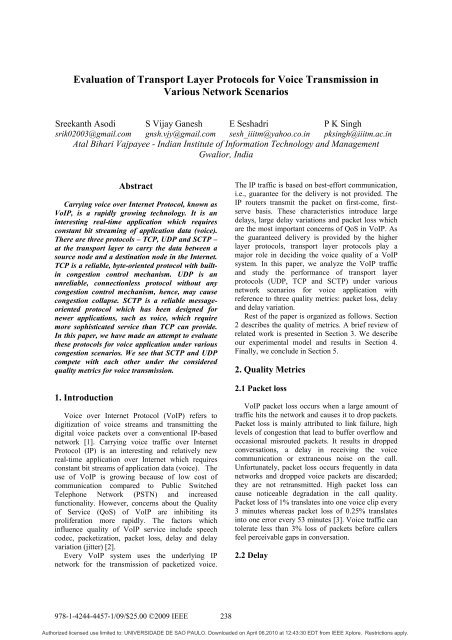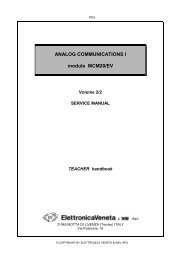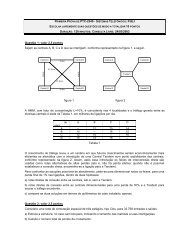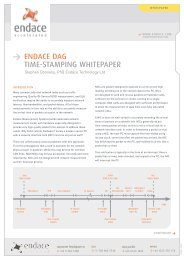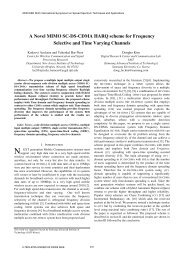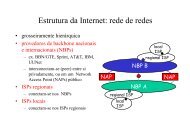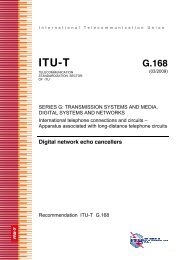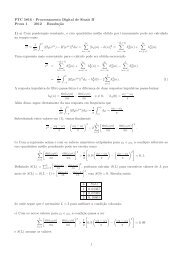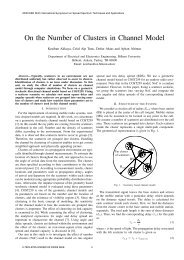Evaluation of Transport Layer Protocols for Voice ... - ResearchGate
Evaluation of Transport Layer Protocols for Voice ... - ResearchGate
Evaluation of Transport Layer Protocols for Voice ... - ResearchGate
You also want an ePaper? Increase the reach of your titles
YUMPU automatically turns print PDFs into web optimized ePapers that Google loves.
<strong>Evaluation</strong> <strong>of</strong> <strong>Transport</strong> <strong>Layer</strong> <strong>Protocols</strong> <strong>for</strong> <strong>Voice</strong> Transmission inVarious Network ScenariosSreekanth Asodisrik02003@gmail.comS Vijay Ganeshgnsh.vjy@gmail.comE Seshadrisesh_iiitm@yahoo.co.inP K Singhpksingh@iiitm.ac.inAtal Bihari Vajpayee - Indian Institute <strong>of</strong> In<strong>for</strong>mation Technology and ManagementGwalior, IndiaAbstractCarrying voice over Internet Protocol, known asVoIP, is a rapidly growing technology. It is aninteresting real-time application which requiresconstant bit streaming <strong>of</strong> application data (voice).There are three protocols – TCP, UDP and SCTP –at the transport layer to carry the data between asource node and a destination node in the Internet.TCP is a reliable, byte-oriented protocol with builtincongestion control mechanism. UDP is anunreliable, connectionless protocol without anycongestion control mechanism, hence, may causecongestion collapse. SCTP is a reliable messageorientedprotocol which has been designed <strong>for</strong>newer applications, such as voice, which requiremore sophisticated service than TCP can provide.In this paper, we have made an attempt to evaluatethese protocols <strong>for</strong> voice application under variouscongestion scenarios. We see that SCTP and UDPcompete with each other under the consideredquality metrics <strong>for</strong> voice transmission.1. Introduction<strong>Voice</strong> over Internet Protocol (VoIP) refers todigitization <strong>of</strong> voice streams and transmitting thedigital voice packets over a conventional IP-basednetwork [1]. Carrying voice traffic over InternetProtocol (IP) is an interesting and relatively newreal-time application over Internet which requiresconstant bit streams <strong>of</strong> application data (voice). Theuse <strong>of</strong> VoIP is growing because <strong>of</strong> low cost <strong>of</strong>communication compared to Public SwitchedTelephone Network (PSTN) and increasedfunctionality. However, concerns about the Quality<strong>of</strong> Service (QoS) <strong>of</strong> VoIP are inhibiting itsproliferation more rapidly. The factors whichinfluence quality <strong>of</strong> VoIP service include speechcodec, packetization, packet loss, delay and delayvariation (jitter) [2].Every VoIP system uses the underlying IPnetwork <strong>for</strong> the transmission <strong>of</strong> packetized voice.The IP traffic is based on best-ef<strong>for</strong>t communication,i.e., guarantee <strong>for</strong> the delivery is not provided. TheIP routers transmit the packet on first-come, firstservebasis. These characteristics introduce largedelays, large delay variations and packet loss whichare the most important concerns <strong>of</strong> QoS in VoIP. Asthe guaranteed delivery is provided by the higherlayer protocols, transport layer protocols play amajor role in deciding the voice quality <strong>of</strong> a VoIPsystem. In this paper, we analyze the VoIP trafficand study the per<strong>for</strong>mance <strong>of</strong> transport layerprotocols (UDP, TCP and SCTP) under variousnetwork scenarios <strong>for</strong> voice application withreference to three quality metrics: packet loss, delayand delay variation.Rest <strong>of</strong> the paper is organized as follows. Section2 describes the quality <strong>of</strong> metrics. A brief review <strong>of</strong>related work is presented in Section 3. We describeour experimental model and results in Section 4.Finally, we conclude in Section 5.2. Quality Metrics2.1 Packet lossVoIP packet loss occurs when a large amount <strong>of</strong>traffic hits the network and causes it to drop packets.Packet loss is mainly attributed to link failure, highlevels <strong>of</strong> congestion that lead to buffer overflow andoccasional misrouted packets. It results in droppedconversations, a delay in receiving the voicecommunication or extraneous noise on the call.Un<strong>for</strong>tunately, packet loss occurs frequently in datanetworks and dropped voice packets are discarded;they are not retransmitted. High packet loss cancause noticeable degradation in the call quality.Packet loss <strong>of</strong> 1% translates into one voice clip every3 minutes whereas packet loss <strong>of</strong> 0.25% translatesinto one error every 53 minutes [3]. <strong>Voice</strong> traffic cantolerate less than 3% loss <strong>of</strong> packets be<strong>for</strong>e callersfeel perceivable gaps in conversation.2.2 Delay978-1-4244-4457-1/09/$25.00 ©2009 IEEE 238Authorized licensed use limited to: UNIVERSIDADE DE SAO PAULO. Downloaded on April 06,2010 at 12:43:30 EDT from IEEE Xplore. Restrictions apply.
Transmission time or delay is the average time ittakes <strong>for</strong> a packet to travel from its source to itsdestination. Delay causes disruption in the voicequality when voice packets take more time thanexpected to reach their destination. The InternationalTelecommunications Union (ITU) recommendationG.114 [4] considers network delay <strong>for</strong> voiceapplications. This recommendation defines 3 bands<strong>of</strong> one-way delay with adequately controlled echo asshown in the table 1. A voice call can toleratemaximum latency (delay) <strong>of</strong> 150 milliseconds,however, 100 milliseconds is preferred.2.3 Delay VariationIf the delay is small and constant, the speech maybe acceptable. However, the delay is variable inpacketized networks; this variation in delay is knownas jitter. It is effectively a variation <strong>of</strong> packet delaywhere delays actually impact quality <strong>of</strong> theconversation. It can be handled through the de-jitterbuffer at the receiving router/gateway. De-jitterbuffer imposes a delay on early packets and passeslate packets with less delay to compensate thevariable delay. Any packet which arrives later thanthe length <strong>of</strong> buffer is discarded. The buffer shouldbe able to compensate the maximum delay variationthat we expect. It will minimize packet loss too. Nowonwards, we will use the term ‘jitter’ <strong>for</strong> delayvariation in the paper.Range inmillisecondsTable 1. Delay BandsDescription0-150 Accepable <strong>for</strong> most user applications150-400Above 4003. Related WorkAcceptable <strong>for</strong> internationalconnectionsUnaccepable <strong>for</strong> general networkplanning purposes; however, it isrecognised that in some exceptationalcases this limit will be exceededChang and Su [5] compare the per<strong>for</strong>mance <strong>of</strong>TCP and UDP <strong>for</strong> P2P streaming media withreference to average values <strong>of</strong> missing index andaverage download rate. They conclude that bothUDP and TCP provide reasonable service quality butTCP is more stable and reliable. It is partly thereason that most P2P streaming systems use TCP asits transport protocol. Kiesel and Scharf [6] study theper<strong>for</strong>mance <strong>of</strong> SCTP, TCP and UDP over a firewallsignaling protocol - simple middlebox configurationprotocol (SIMCO). They observe that SCTPsignificantly outper<strong>for</strong>m TCP because <strong>of</strong> its ability totransmit over multiple streams; SCTP reduces theresponse time <strong>of</strong> SIMCO. TCP and UDP both sufferfrom significantly larger delays.Ha et al. [7] study the throughput per<strong>for</strong>mance <strong>of</strong>SCTP and TCP over the Linux plat<strong>for</strong>m underdifferent scenarios as variable size <strong>of</strong> user’s inputdata and fairness under competition <strong>of</strong> traffic. Theyobserve that SCTP outper<strong>for</strong>m TCP in throughputand fairly competes with it. They also observe thatmulti-homing SCTP provides better per<strong>for</strong>mancethan the single-homing case. Camarillo et al. [8]implements SIP over SCTP, UDP and TCP protocolsunder different network conditions and observe thatUDP is good only <strong>for</strong> the light traffic. Under heavytraffic load, TCP and SCTP are better than UDP.However, SCTP has some advantage over TCPowing to its features as multi-streaming and multihoming.In general, SCTP per<strong>for</strong>mance increaseswith worsening <strong>of</strong> network conditions.Wang et al. [9] study the per<strong>for</strong>mance <strong>of</strong> PR-SCTP (an unreliable extension <strong>of</strong> SCTP), TCP, andUDP <strong>for</strong> MPEG-4 video traffic over mobilenetworks. They observe that PR_SCTP is moresuitable <strong>for</strong> real-time traffic as its selectiveretransmission can improve the quality <strong>of</strong> images.Moreover, it can provide unified congestion controlto both reliable and unreliable traffic which is notpossible by any other protocol.Kumazoe et al. [10] study the throughputcharacteristic <strong>of</strong> high speed transport protocols:HighSpeed TCP (HSTCP), Scalable TCP and SimpleAvailable Bandwidth Utilization Library (SABUL)experimenting on the Japan Gigabit Network (JGN).They observe that in TCP-based protocols the simpleand robust strategy <strong>of</strong> ACK packets <strong>for</strong> rate and errorcontrol works well with variety <strong>of</strong> networkcircumstances but it may not be suitable <strong>for</strong> longdistance networks because per<strong>for</strong>mance depends onboth the distance and receiver-side TCPimplementation. Rate control and error controlmechanisms should be separated <strong>for</strong> betterper<strong>for</strong>mance.Rajamani et al. [11] study the per<strong>for</strong>mance <strong>of</strong>SCTP and TCP over HTTP protocol and concludethat SCTP can help reduce the latency and theimproved throughput. Additionally, other features <strong>of</strong>SCTP like multihoming and better protection againstDoS attacks makes it more suitable <strong>for</strong> future webapplications. Dantas and Jardini [12] compare andobserve that Xpress <strong>Transport</strong> Protocol (XTP) issuperior to TCP <strong>for</strong> reliable multicastcommunications. Heidemann et al. [13] develop ananalytical model and use it to compare the relativeper<strong>for</strong>mance <strong>of</strong> TCP, Transaction TCP and requestresponseprotocol based on UDP over HTTP <strong>for</strong>various network characteristics and workloads.Hence, the literature suggests that per<strong>for</strong>mancestudy <strong>of</strong> transport layer protocols is crucial <strong>for</strong> any IPbased network application. VoIP is becomingincreasingly popular and has the potential to replace239Authorized licensed use limited to: UNIVERSIDADE DE SAO PAULO. Downloaded on April 06,2010 at 12:43:30 EDT from IEEE Xplore. Restrictions apply.
the existing telephony system. A VoIP applicationhas two phases: signaling and voice transmission. In[8], the authors have evaluated the per<strong>for</strong>mance <strong>of</strong>transport layer protocols <strong>for</strong> SIP which is a VoIPsignaling protocol. It motivated us to evaluate theper<strong>for</strong>mance <strong>of</strong> various transport layer protocols indifferent network conditions <strong>for</strong> streaming mediaapplications, e.g., VoIP.4. Experimental Model and Results4.1 Experimental modelWe consider the simulation model as suggestedby Camarillo et al. [8] and use the network simulator(ns 2.31) <strong>for</strong> the simulation. Figure 1 shows thetypical network topology. Nodes 2 and 3 are bufferlimitedtail drop routers which treat each packetidentically and drop the newly arrived packets ifqueue is full to its maximum capacity until the queuehas enough room to accept incoming traffic. Othernodes are the end nodes. Nodes 1 and 5 are the VoIPsource and sink respectively. Nodes 0 and 4 are used<strong>for</strong> simulating FTP traffic while the nodes 6 and 7are used to simulate the pack mime HTTP traffic. Asingle PackMime-HTTP client node generates HTTPconnections coming from a “cloud” <strong>of</strong> web clients.Likewise, a single PackMime-HTTP server nodeaccepts and serves HTTP connections destined <strong>for</strong> a“cloud” <strong>of</strong> web servers. There are many clientapplications assigned to a single client node andmany server applications assigned to a single servernode [15]. All the simulated traffic shares thecommon link 2-3. Thus, this link acts as a bottleneck<strong>for</strong> the entire traffic. We can easily study the networkbehavior in different networking scenarios bychanging the parameters <strong>for</strong> this bottleneck link.2Mbps, (ii) hLlB - a high latency, low bandwidthscenario with a delay <strong>of</strong> 140ms and bandwidth <strong>of</strong> 0.6Mbps, and (iii) lLhB – a low latency, high bandwidthscenario with a delay <strong>of</strong> 70ms and bandwidth <strong>of</strong> 2Mbps. The parameters between other links (exceptlink 2-3) are as shown in Figure 1 and were notchanged during the experiments. We simulate eachscenario <strong>for</strong> 300 seconds and compute mean value <strong>of</strong>the delay and delay jitter <strong>for</strong> every consecutive timeinterval <strong>of</strong> 5 seconds.4.2. ResultsHigh Latency, High Bandwidth (hLhB)Scenario: Figures 2 and 3 represent the end to enddelay and jitter respectively. Figure 2 shows theexpected trends <strong>of</strong> the delay. The initial peaks in thedelay <strong>of</strong> SCTP and TCP are due to the initialhandshake at the time <strong>of</strong> connection establishment.As SCTP has a four way handshake [18], its initialpeak is the highest. The intermediate peaks in TCPand SCTP are due to the high congestion and apossible packet loss, which increases the delay. TheUDP shows a constant delay as, being aconnectionless protocol, it maintains the data rate.We observe, initial low value <strong>of</strong> delay in UDP (refer,Figure 2) because the competitive traffic <strong>of</strong> TCP andSCTP are still in connection establishment stagethen, hence giving UDP a free link to communicate.Later, when the TCP, SCTP, FTP and HTTP trafficestablishes completely, the delay increases because<strong>of</strong> the high traffic.Figure 1. Simulated Network TopologyIn this monogram, we study the transport layerprotocols with the three per<strong>for</strong>mance metrics: (i)packet loss, (ii) delay, and (iii) jitter <strong>for</strong> the VoIPtraffic between node 1 and node 5 by changing theparameters <strong>of</strong> the bottleneck link 2-3 <strong>for</strong> creatingdifferent scenarios. We study three differentscenarios: (i) hLhB - a high latency, high bandwidthscenario with a delay <strong>of</strong> 140ms and bandwidth <strong>of</strong>Figure 2. Delay in hLhB scenarioFigure 3 shows the jitter. As UDP does not have acongestion control and packet re-transmissionmechanisms [16], it continuously sends the packetsat a constant rate in to the network. Thus, we do notobserve much difference in the delay. As a result thejitter, which is the variation <strong>of</strong> packet delays, is verylow. In case <strong>of</strong> TCP and SCTP, we observe peaks <strong>of</strong>jitter because <strong>of</strong> the congestion control and packetre-transmission mechanisms in these protocols.240Authorized licensed use limited to: UNIVERSIDADE DE SAO PAULO. Downloaded on April 06,2010 at 12:43:30 EDT from IEEE Xplore. Restrictions apply.
Figure 3. Jitter hLhB scenarioFigure 4. Delay in hLlB scenarioThough UDP per<strong>for</strong>ms better in delay and jitter,we observe comparatively more packet loss (refer,Table 2). However, it is well within the limit tocause any noticeable degradation in the call quality.Table 2. Packet loss in hLhB scenarioProtocol Packets No. <strong>of</strong> % lossSent packets lostSCTP 4716 54 1.145TCP 4978 49 0.984UDP 4990 62 1.242High latency, Low bandwidth (hLlB) scenario:It is a typical existing scenario in the Internet. Figure4 shows the average delay. The average delay <strong>of</strong>TCP traffic is observed to be in the range <strong>of</strong> 260-280ms whereas the delay <strong>of</strong> UDP and SCTP is observedto be varying between 220-240 ms. The initial peaksin TCP and SCTP, and the initial low delay in UDPmay be explained as in the previous (hLhB) scenario.The intermediate high peaks in TCP and SCTP maybe attributed to the congestion; due to congestion inthe bottleneck link multiple packets get delayedresulting in a momentary increase (a peak) in theaverage delay. It triggers congestion controlmechanism, which reduces throughput in theseprotocols.Figure 5. Jitter in hLlB scenarioLow latency, High bandwidth (lLhB) scenario:It is a typical scenario which exists in the backbone<strong>of</strong> Internet. Hence, it is the most desirable scenari<strong>of</strong>or any study <strong>of</strong> the data transmission on a network.The delay shows an expected behavior by havingvery low end to end delay compared to otherscenarios. The average delay <strong>of</strong> VoIP over TCP isobserved around 180-190 ms while the average delay<strong>of</strong> VoIP over SCTP and UDP both is observedaround 140-160 ms (refer, Figure 6). The SCTP andUDP are comparable to each other. The initial highdelay in SCTP is due to the initial 4-way handshakeconnection establishment. A low delay in SCTP andUDP favors them <strong>for</strong> efficient packet transmission.Table 3. Packet loss in hLlB scenarioProtocol Packets No. <strong>of</strong> % lossSent packets lostSCTP 4721 52 1.101TCP 5009 55 1.098UDP 4990 50 1.002Figure 5 shows the jitter. The jitter may beexplained as in the previous (hLhB) scenario.However, jitter in TCP is comparatively higher. Inthis case, packet loss in the UDP is least (refer, Table3).Figure 6. Delay in lLhB scenario241Authorized licensed use limited to: UNIVERSIDADE DE SAO PAULO. Downloaded on April 06,2010 at 12:43:30 EDT from IEEE Xplore. Restrictions apply.
Table 4. Packet loss in lLhB scenarioProtocol Packets No. <strong>of</strong> % lossSent packets lostSCTP 5041 53 1.051TCP 5025 53 1.055UDP 4990 57 1.142Figure 7 shows the jitter. As expected, thebehavior <strong>of</strong> UDP is better as its delay <strong>of</strong> all thepackets is very similar, hence jitter is negligible.Since TCP is having high variation in delay because<strong>of</strong> its congestion control mechanisms [17], its jitter ishigh compared to that <strong>of</strong> SCTP and UDP. In thisscenario, behavior <strong>of</strong> SCTP is same as that <strong>of</strong> theUDP. Though, in this case also UDP per<strong>for</strong>ms betterin delay and jitter, like hLhB, we observecomparatively more packet loss (refer, Table 3).However, it is well within the limit to cause anynoticeable degradation in the call quality.5. ConclusionFigure 7. Jitter in lLhB scenarioOur study supports statistically the superiority <strong>of</strong>UDP over TCP and SCTP in all the scenarios. Thegood per<strong>for</strong>mance <strong>of</strong> UDP in VoIP applicationsmakes it a preferred transport layer protocol to carryvoice packets from source to destination, e.g., Skype[14] uses UDP. However, it is likely that SCTP mayper<strong>for</strong>m better with some modifications/extensions inthe protocol as, we observe, its per<strong>for</strong>mance iscomparable to UDP in most <strong>of</strong> the cases. We areworking towards this goal as such modified SCTPwill be more promising because it overcomes theshortcomings <strong>of</strong> both UDP, e.g., traffic controlmechanism, and TCP, e.g., head <strong>of</strong> line blocking.[3] “VoIP Service Level FAQ – VoIP News”, URL:http://www.voip-news.com/faq/voip-service-levelfaq/[4] “One Way Transmission Time”, ITU-TRecommendation G.114, 1996[5] J. Y. Chang, and X, Su,”An <strong>Evaluation</strong> <strong>of</strong> <strong>Transport</strong><strong>Protocols</strong> in Peer-to-Peer Media Streaming”, In Proc.International Conference on Networking,Architecture, and Storage, IEEE Computer Society,pp. 241-247, 2008.[6] S. Kiesel, and M. Scharf,”Modeling and Per<strong>for</strong>mance<strong>Evaluation</strong> <strong>of</strong> <strong>Transport</strong> <strong>Protocols</strong> <strong>for</strong> FirewallControl”, International Journal <strong>of</strong> Computer andTelecommunications Networking, Vol. 51, Issue. 11,pp. 3232-3251, August 2007.[7] J. S. Ha, S. T. Kim, and S. J. Koh,”Per<strong>for</strong>manceComparison <strong>of</strong> SCTP and TCP over Linux Plat<strong>for</strong>m”.In Proc. International Conference on IntelligentComputing, Springer, LNCS 3645, pp.396-404. 2005.[8] G. Camarillo, R. Kantola, and H.Schulzrinne,”<strong>Evaluation</strong> <strong>of</strong> <strong>Transport</strong> <strong>Protocols</strong> <strong>for</strong>the Session Initian Protocol”, IEEE Networks, pp. 40-46, October 2003.[9] H. Wang, Y. Jin, and W. Wang,”The Per<strong>for</strong>manceComparison <strong>of</strong> PRSCTP, TCP and UDP <strong>for</strong> Mpeg-4Multimedia Traffic in Mobile Network”, In Proc.International Conference <strong>of</strong> CommunicationTechnology, pp. 403-406, April 2003.[10] K. Kazumi, Y. Hori, M. Tsuru and Y. Oie,” <strong>Transport</strong><strong>Protocols</strong> <strong>for</strong> Fast Long-Distance Networks:Comparison <strong>of</strong> Their Per<strong>for</strong>mances in JGN”, In Proc.Symposium on Applications and the Internet-Workshops (SAINT 2004 Workshops), pp.645, 2004.[11] R. Rajamani, S. Kumar and N. Gupta,”SCTP versusTCP: Comparing the Per<strong>for</strong>mance <strong>of</strong> <strong>Transport</strong><strong>Protocols</strong> <strong>for</strong> Web Traffic”, Tech report: University <strong>of</strong>Wisconsin-Madison, July 22, 2002.[12] M. A. R. Dantas and G. Jardini,”Per<strong>for</strong>mance<strong>Evaluation</strong> <strong>of</strong> XTP and TCP <strong>Transport</strong> <strong>Protocols</strong> <strong>for</strong>Reliable Multicast Communications”, In Proc. 9thInternational Conference on High-Per<strong>for</strong>manceComputing and Networking, Springer:LNCS 2110,pp. 591-594, 2001.[13] J. Heidemann, K. Obraczka and J. Touch,”Modelingthe Per<strong>for</strong>mance <strong>of</strong> HTTP Over Several <strong>Transport</strong><strong>Protocols</strong>”, IEEE/ACM Trans. On Networking, Vol.5,No.5, pp.616-630, 1997.[14] “Skype Official Website”, URL:http://www.skype.com/intl/en/[15] “PackMime-HTTP”, URL:http://www.isi.edu/nsnam/ns/doc/node552.html[16] J. Postel,” UDP: User Datagram Protocol”, IETF RFC768,1980.[17] M. Allman, V. Paxson and W. Stevens, “TCPCongestion Control”, IETF RFC 2581, 1999.[18] R. Stewart, Q. Xie, K. Morneault, H. Schwarzbauer,T. Taylor, I. Rytina, M. Kalla, L. Zhang and V.Paxson, “Stream Control Transmission Protocol”,IETF RFC 2960, 2000.References[1] C. I. Oliver, “Converged Nertwork Architectures,Delivering <strong>Voice</strong> and Data over IP, ATM, and FrameRelay”, 1 st Ed., USA, John Wiley & Sons, 2002.[2] B. goode, “Voive Over Internet Protocol (VoIP)”,Proceedings <strong>of</strong> the IEEE, Vol. 90, No. 9, pp. 1495-1517, September 2002.242Authorized licensed use limited to: UNIVERSIDADE DE SAO PAULO. Downloaded on April 06,2010 at 12:43:30 EDT from IEEE Xplore. Restrictions apply.


